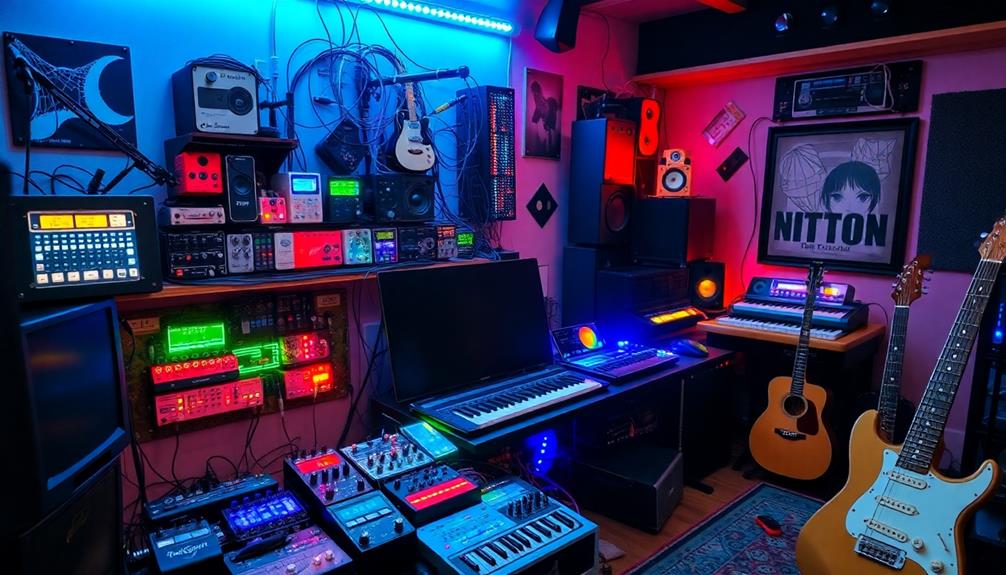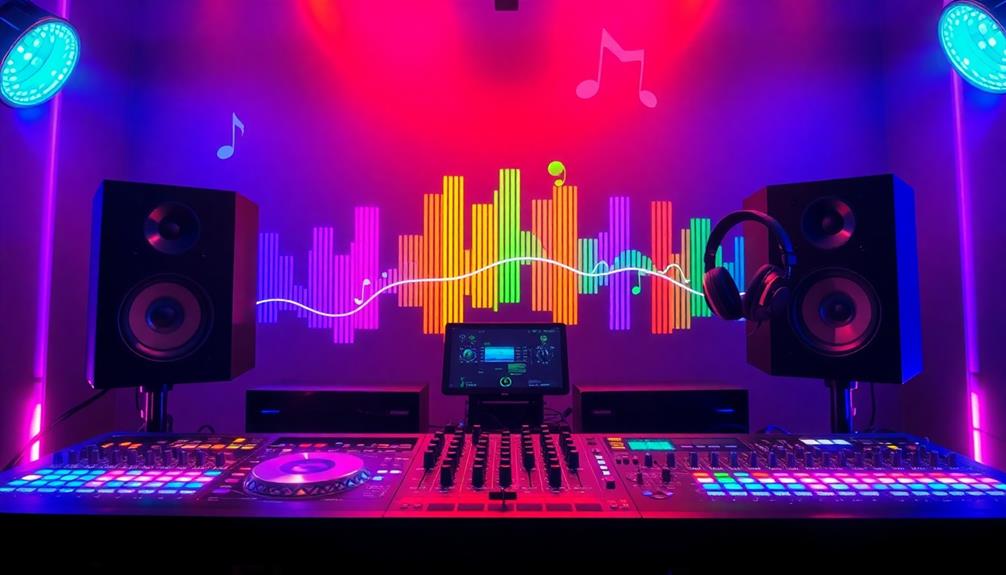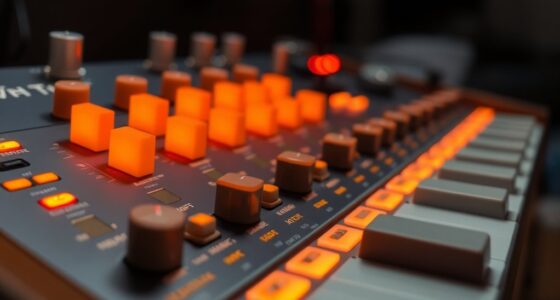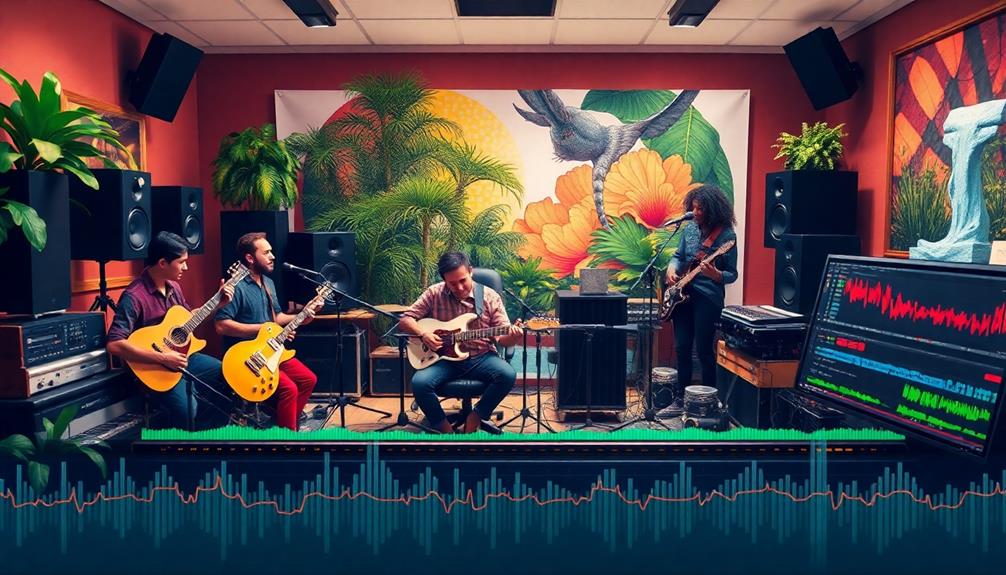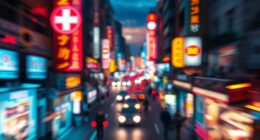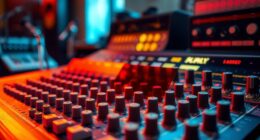You plunge into the enchanting world of ambient soundscapes, where your artistry creates immersive auditory experiences. By blending background noise, layered textures, and dynamic elements, you enhance emotional engagement. Utilize field recordings and spatialization techniques to add depth and authenticity to your designs. High-quality tools like digital audio workstations and synthesizers let you explore and manipulate sound. As you craft these sonic environments, you not only support artistic expressions but also shape how audiences connect with stories and media. If you keep exploring, you'll uncover more techniques and insights that can elevate your sound design to new heights.
Key Takeaways
- Ambient soundscapes enhance emotional engagement and immersion in various media, creating rich auditory experiences for listeners.
- Techniques like field recording, layering, and effects processing contribute to the authenticity and depth of soundscapes.
- Mastering spatialization techniques and dynamic range management is essential for creating immersive three-dimensional auditory environments.
- Utilizing high-quality tools, such as microphones and DAWs, allows for detailed editing and mixing to achieve cohesive soundscapes.
- Dynamic sounds and adaptive layering foster enhanced gameplay experiences, connecting players emotionally to the game world.
Understanding Ambient Soundscapes

Ambient soundscapes are more than just background noise; they're intricate audio environments that can profoundly shape your emotional experience. As a sound designer, you can create these layered audio experiences to enhance mood and immersion.
By understanding impulse response, you can simulate how sound interacts with different spaces, adding depth to your sound. This technique allows you to craft environments that feel real, whether it's a serene forest or a bustling city. Incorporating techniques like field recording can greatly enhance authenticity, offering a more genuine auditory experience.
To truly engage your audience, consider incorporating a variety of elements into your soundscapes. Start with a foundational layer of background noise, then layer textures that add richness and complexity.
Dynamics play a vital role too, as they can evoke emotions and draw listeners in. Spatialization techniques help create a sense of direction and distance, making the experience more immersive.
Utilizing field recordings adds authenticity, while synthesis can introduce unique sounds. Looping your audio guarantees continuity, and effects processing, like reverb and delay, gives added depth to your sound.
Mastering these techniques will allow you to create compelling soundscapes that seamlessly blend into their environments, enhancing both focus and relaxation.
Essential Soundscape Elements

To create an engaging soundscape, you need to understand the essential elements that come together to form a cohesive auditory experience. These elements work in harmony to immerse listeners in your designed environment.
Here's a quick overview of these elements:
| Element | Description | Importance |
|---|---|---|
| Background Noise | Serves as the foundation, blending into the environment without overpowering other sounds. | Creates a sense of place and context. |
| Textures | Achieved by layering multiple sound sources, adding richness and complexity to the soundscape. | Enhances immersion and depth. |
| Dynamics | Involves volume changes and variations in intensity to evoke emotional responses. | Engages listeners on a deeper level. |
| Spatialization | Techniques like panning and distance simulation create direction and depth. | Makes the soundscape feel realistic. |
Incorporating background noise, textures, and spatialization into your soundscape lays the groundwork for an engaging auditory experience. By mastering these elements, you can evoke emotions and transport listeners into another dimension, enhancing their connection to your crafted environment.
Techniques for Sound Design
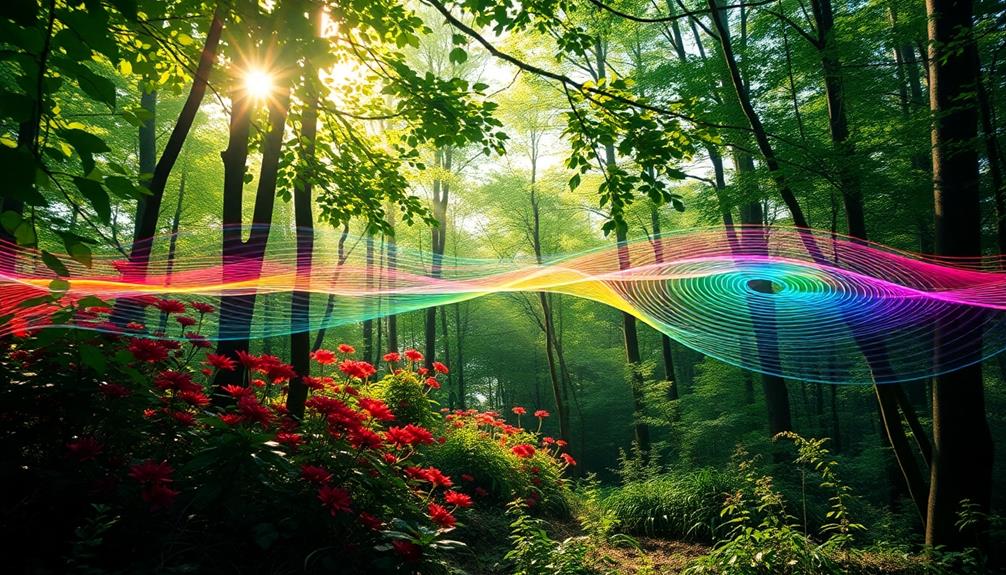
Releasing the potential of sound design requires mastering various techniques that breathe life into your soundscapes. Start with field recording; it's a foundational technique for capturing authentic sounds from your environment. This gives you a rich source of material to work with.
Next, focus on layering multiple sound sources. This essential practice creates complex and immersive soundscapes, adding varied textures and dynamics that elevate the listening experience.
Don't forget about effects processing. Utilizing tools like reverb and delay can greatly enhance the spatialization of your sounds. This adds depth and a sense of distance, making your audio environment more engaging.
Automation of sound levels and effects also plays a key role. By enabling dynamic changes, you create a responsive auditory experience that mirrors real-world acoustics.
Additionally, techniques like looping and synthesis can generate continuous and unique sound elements, contributing to the overall cohesion and flow of your ambient soundscape.
Tools for Creating Soundscapes

Creating immersive soundscapes hinges on using the right tools at your disposal. To capture authentic sounds and craft layered audio experiences, you'll want to invest in essential equipment and software.
Here are some key tools to take into account:
- High-quality microphones for field recording, ensuring you capture detailed sounds from natural and urban environments.
- Digital Audio Workstations (DAWs) like Ableton Live or Pro Tools, which provide robust editing and mixing capabilities for sound manipulation.
- Synthesizers that allow you to explore unique synthetic sounds, enriching your soundscapes with creativity beyond real-world recordings.
- Audio interfaces to connect your microphones and instruments to your computer, ensuring high fidelity in sound transmission and recording.
- Plugins such as reverb and delay effects, which enhance the depth and spatialization of your soundscapes.
Implementing Soundscapes in Media

When you implement soundscapes in media, you enhance emotional engagement, making stories more impactful.
In video games, these sound environments create immersive gameplay experiences that respond to your actions.
Additionally, soundscapes support artistic expression by complementing visuals and evoking deeper emotional responses from the audience.
Enhancing Emotional Engagement
Ambient soundscapes can transform media experiences by enhancing emotional engagement and deepening your connection to the narrative.
Whether you're watching a film, playing a video game, or experiencing an art installation, the right soundscapes can evoke powerful emotions and create lasting memories.
With advancements in technology, such as the integration of generative AI in media, creators are now able to craft more dynamic and immersive sound environments that resonate deeply with audiences.
Consider these aspects of how ambient soundscapes amplify emotional engagement:
- Mood Reflection: Soundscapes mirror the emotional tone of the story, making moments more impactful.
- Character Connection: A rich auditory environment helps you bond with characters on a deeper level.
- Immersive Experiences: In virtual reality, spatialized audio allows you to navigate your surroundings naturally, heightening your involvement.
- Mindfulness and Relaxation: Calming soundscapes in meditation promote relaxation, enhancing your mindfulness practice.
- Artistic Expression: Soundscapes in art installations invite you to engage multi-sensorially, provoking thought and emotion.
Immersive Gameplay Experiences
In video games, soundscapes play a pivotal role in immersing you in the experience, making each environment feel alive and responsive. By using ambient sounds, developers create a sonic destination that draws you deeper into the game world. Every sound you hear, from rustling leaves to distant chatter, enhances your connection to the environment, making it feel dynamic and real.
Spatialization techniques, like reverb and delay, simulate the acoustics of various settings, giving you a sense of depth and realism. When you move through a space, the sounds shift, reflecting your position and distance, which keeps you engaged and aware of your surroundings.
Moreover, the effective use of looping tracks and dynamic volume adjustments helps maintain clarity while enriching atmospheric depth. This balance guarantees that ambient sounds complement critical gameplay audio cues without overpowering them.
Techniques like field recording and procedural generation introduce authenticity and unpredictability to the audio landscape, layering urban noise or nature sounds to create a rich tapestry of sound. Together, these elements enhance your gameplay experience, allowing you to fully immerse yourself in the world the developers have created.
Supporting Artistic Expression
Soundscapes are essential for supporting artistic expression across various media, enriching the audience's experience. By implementing carefully crafted soundscapes, you can evoke emotions and enhance storytelling, making your project more impactful.
Additionally, the careful selection of sound can mimic the importance of credit card insights in financial management, ensuring that each element serves a purpose in your artistic vision. Keep in mind how these soundscapes function within the space of your art—whether it's a film, video game, or installation.
Consider these key aspects:
- Emotional Engagement: Soundscapes deepen the connection between the audience and the narrative.
- Immersive Environments: In video games, they make players feel part of the world.
- Mindfulness Enhancement: Meditation practices utilize sounds to promote relaxation.
- Auditory Experiences: Art installations engage audiences through multisensory environments.
- Realistic Presence: Virtual reality relies on sound to complement visuals.
When you design soundscapes, think about Gayes Whats and how the auditory elements can enhance your artistic vision.
The right sound can transform a simple scene into a profound experience, making it memorable and resonant with your audience. Embrace the power of sound to elevate your creative expression and connect more deeply with those who engage with your work.
The Role of Ambience

Creating an immersive experience relies heavily on the role of ambience in sound design. Ambience acts as the foundational layer of your soundscapes, providing essential background noise that enhances emotional depth and immersion. By carefully selecting sounds that blend seamlessly into the background, you guarantee they support rather than overpower key audio elements.
Focus on middle frequencies, around 350Hz to 2kHz, to maintain clarity and avoid clutter. This allows your audience to feel the environment without being distracted. Dynamic variations in volume can create a sense of distance and directionality, making ambient sounds feel more realistic.
Layering multiple sound sources with different distances and textures adds richness to your soundscape, making it more complex and believable. Managing sound occurrence frequency and timing is vital, as these factors enhance the overall balance of the ambience.
Spatialization Techniques
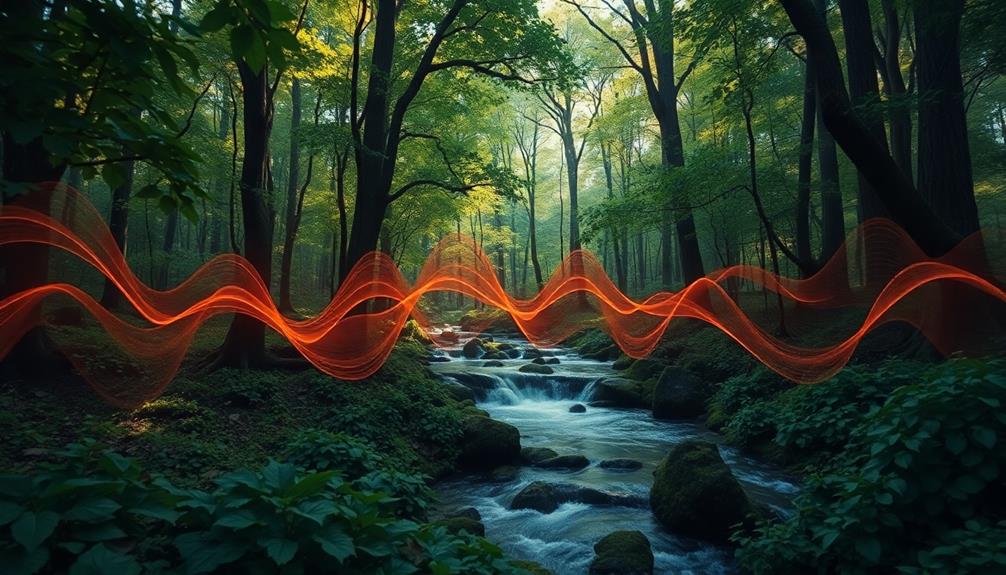
When you're creating immersive soundscapes, understanding spatialization techniques is key.
You can enhance distance perception by employing layering for depth and managing dynamic range effectively.
These methods allow you to craft a more engaging listening experience that feels true to life.
Distance Perception Techniques
Utilizing spatialization techniques can transform your auditory experience by skillfully manipulating sound placement to convey a sense of direction and distance.
By employing various distance perception techniques, you can create immersive soundscapes that captivate your audience. Here are some effective methods to contemplate:
- Convolution Reverb: Simulate specific acoustic spaces, making sounds feel more integrated.
- Automation of Send Levels: Adjust reverb and delay to make sounds seem closer or further away.
- EQ Adjustments Post-Reverb: Remove high frequencies to enhance clarity without losing depth.
- Layered Sounds: Use multiple sound layers at varying distances for a richer auditory experience.
- Dynamic Panning: Shift sounds across the stereo field to enhance the perception of movement and distance.
Layering for Depth
Layering sounds is like building a three-dimensional auditory landscape, where each element contributes to a sense of depth and space. By combining multiple sound sources at varying distances, you create a richer, more immersive experience that allows listeners to perceive spatial relationships. To improve clarity, utilize different frequency ranges in your layers; this prevents clutter and guarantees every sound stands out.
Spatialization techniques, like panning and adjusting volume, simulate the listener's position relative to sound sources, making the environment feel dynamic and realistic. Incorporating reverb and delay effects selectively within your layers can further improve this sense of space, allowing you to mimic various acoustic environments and distances.
You can also automate levels and effects across your layers, creating evolving soundscapes that respond to the listener's experience. This not only adds emotional depth but also keeps your audience engaged.
Dynamic Range Management
Dynamic range management is essential for creating enchanting ambient soundscapes, as it balances loud and soft sounds to maintain clarity and emotional impact. By effectively managing this range, you'll guarantee that no sound overwhelms the listener, allowing them to fully immerse in the experience.
To enhance your ambient soundscapes, consider these spatialization techniques:
- Use reverb and delay to create a sense of distance and direction.
- Automate send levels to simulate distance perception, adding depth to your mix.
- Apply EQ adjustments post-reverb to control high frequencies, preventing muddiness.
- Utilize convolution reverb to accurately replicate specific acoustic environments for realism.
- Layer sounds strategically to create a rich, immersive experience.
These techniques will help you maintain clarity while enhancing the emotional impact of your soundscapes.
By focusing on dynamic range management, you'll create environments that not only sound good but also resonate deeply with your audience.
Remember, it's all about finding the right balance to guide listeners through the sonic journey you've crafted.
With practice and attention to detail, you'll master the art of dynamic range management in your ambient soundscapes.
Community and Resources

While diving into the world of ambient soundscapes, you'll find that engaging with communities and resources can greatly enhance your creativity and skills. Online forums like Gearslutz and Reddit's r/sounddesign are fantastic places to gain insights and feedback from fellow sound designers. Collaborating with local sound art groups or attending workshops can also sharpen your skills and help you connect with other creatives.
Consider exploring projects like Cities and Memory, which promotes global participation in field recording and soundscape creation, fostering cultural exchange. Platforms such as SoundCloud and Bandcamp allow you to share your work, receive critiques, and build a portfolio that can increase your exposure.
Additionally, online courses and webinars from institutions like Coursera and MasterClass offer structured learning opportunities to deepen your understanding of sound design techniques.
Here's a quick overview of some valuable resources:
| Type of Resource | Example |
|---|---|
| Online Communities | Gearslutz, r/sounddesign |
| Collaboration Groups | Local sound art groups |
| Global Projects | Cities and Memory |
| Sharing Platforms | SoundCloud, Bandcamp |
| Learning Opportunities | Coursera, MasterClass |
Engaging with these resources will elevate your soundscape creations.
Impact on Society and Environment
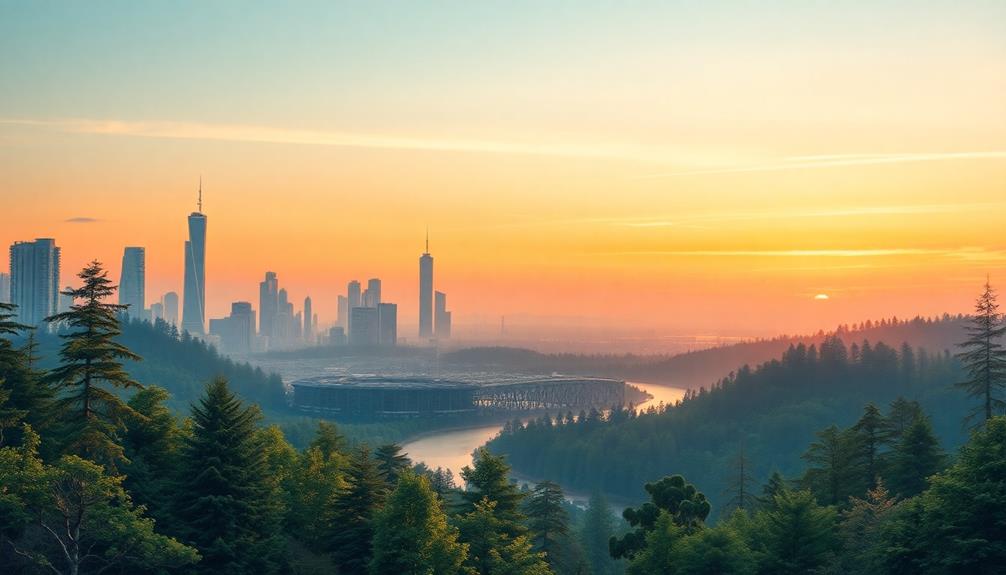
Soundscapes play a significant role in shaping our experiences and perceptions of the world around us. Historically, quieter environments allowed for more intimate connections with nature and community, but modern soundscapes are dominated by technology and urban noise. This shift reflects societal changes, presenting both challenges and opportunities for improvement.
As you consider the impact of sound on your life, take note of these key points:
- Noise Pollution: Modern soundscapes often include HVAC systems and urban traffic, leading to increased stress and health issues.
- Urban Planning: Awareness of sonic environments has prompted urban planners to prioritize noise reduction for better community health.
- Community Initiatives: Efforts focused on reducing noise pollution are fostering a sonically conscious society.
- Personal Reflection: Your relationship with sound can encourage self-reflection and action towards creating your ideal auditory environment.
- Well-being: A well-designed soundscape can promote overall well-being and enhance community engagement.
Frequently Asked Questions
What Is an Ambient Soundscape?
An ambient soundscape's a layered audio environment that shapes your experience. It combines background noise and textures, influencing emotions and focus, enhancing everything from films to meditation, creating immersive atmospheres you can truly feel.
How to Make Ambience Sound?
You think making ambience sound's easy, right? Start by capturing authentic sounds, layering them thoughtfully, and adding effects. With careful attention to detail, you'll create an immersive experience that transforms simple noise into enchanting atmosphere.
How Do You Create a Soundscape?
To create a soundscape, you'll first identify your project's purpose and emotions. Gather diverse sounds, layer them thoughtfully, and refine the mix with spatial effects, ensuring they enhance your narrative without overwhelming it. Experimenting with genrespecific sound design tips can help tailor your soundscape to match the distinct mood or style of your project, whether it’s horror, fantasy, or sci-fi. Pay attention to the pacing and transitions between sounds, as these can influence the listener’s engagement and emotional response. Finally, test your soundscape in different environments to ensure it delivers the intended impact across various playback settings.
What Software Is Used to Make Soundscapes?
Imagine painting with sound; you'll find that DAWs like Ableton Live and Logic Pro, alongside synthesis software like Serum, let you mold, layer, and blend audio into enchanting soundscapes, breathing life into your creative vision.
Conclusion
Creating ambient soundscapes transforms your projects into immersive experiences that can transport listeners to other worlds. By mastering the elements and techniques we've discussed, you can craft soundscapes that resonate deeply and evoke powerful emotions. Don't just create background noise—build sonic universes that captivate and inspire! As you immerse yourself in this art, remember: the right soundscape can make your audience feel as if they're living in a dream, where every sound paints a vivid picture.


